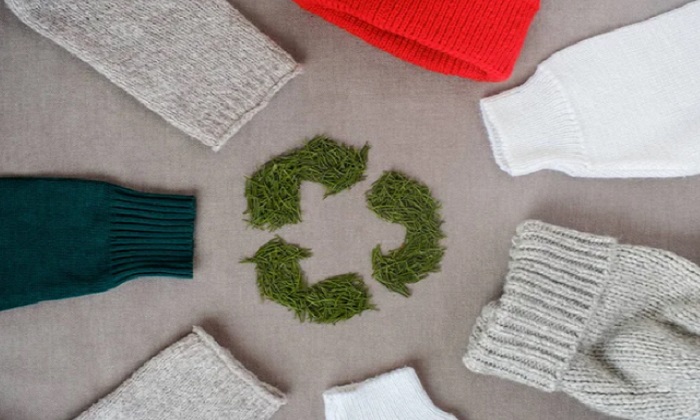The decline in waste management is necessary for the textile sector to grow. Only 25% of textile waste is recycled or repurposed globally; the other 75% is landfilled. It poses an excessive risk to our surroundings. About 20% of the world’s clean water contamination is said to be caused by the manufacture of textiles, namely by dyeing and finishing processes. Three-quarters of the principal microplastics discharged into the environment come from washing synthetic clothing. China and the US create the majority of the world’s 92 million tons of textile waste annually (20 million tons and 17 million tons, respectively). The fact that the textile sector produces more than 92 million tons of trash annually is among the most startling facts. This astounding quantity is the consequence of mass apparel manufacture and—possibly most importantly—the throwaway character of many fashion goods. Data and estimates from the OECD and the Food and Agriculture Organization of the United Nations in 2021 show that throughout the pre- and post-industrial processes involved in the fabrication of cotton clothing in factories, about 11.5 million tons are turned into textile waste.
Method:
Fabric waste that would have otherwise ended up in the garbage may be used to manufacture bricks, which can then be used to create partition walls that insulate heat and construct furniture or decorations. to stop the wastage of worn garments. Textile waste may be disposed of by placing it in collection receptacles. Because it may be recycled, used clothing with rips and holes can even be thrown out on the streets if it is provided for that purpose. Here, we will compress the fabrics using several eco-friendly glue kinds and mould-making techniques to create a “Prototype” that is well-suited to holding things together. It tolerates dampness and reacts to fire effectively. We are aware that cotton is an excellent insulator of heat and sound in our clothes. Moreover, the bricks are fireproof and waterproof thanks to the adhesive employed in their construction.
Paper may also be made by recycling leftover textiles from clothing industries. In this procedure, discarded paper and shreds of fabric are initially put in a tank to be turned into a pulp or paste. After that, sheets are made using very thin layers of pulp. Heavy equipment is used to compress these sheets. They will then be smoothed and dried for two days. They are then uniformly cut and used for paper bags, stationery, decorations, and other things.
Both the SDG objectives and manufacturing costs will be met by the recycled textile method.
The mechanical method of recycling textiles:
The recommended technique for recycling various types of textile waste is mechanical recycling since it is simple and inexpensive. The most common method for recovering post-consumer textile waste is mechanical recycling. Using cutting, shredding, carding, and other mechanical techniques, the fabric is separated into fibers during the mechanical recycling process.
Chemical Method for Recycling Textiles:
Chemical recycling, or the depolymerization of polymers, is an additional technique for using recovered textile waste. Polymers are broken down chemically and biologically into their constituent monomeric building units.
The Vital Justification for Recycled Textiles:
Only when such garbage is recycled, repurposed, and put to good use will we be able to realize our ideal of a green planet. For instance, plastic bottles may be recycled after being used and disposed of. Likewise, waste materials from textiles may be recycled. There’s a big misperception that recycling just applies to plastic and paper products. It is essential to realize that recycling waste materials from the textile industry is equally significant. To find possibilities, such as suggestions for recycling textiles, people need to search online. If altruism starts at home, then recycling textiles also starts with little steps!
You may also enjoy: An Overview of Textile Recycling
We are aware that the production of clothing requires resources like water, power, and other things. Reusing and recycling these things leads to energy conservation. A little action may have a big influence on post-consumer textile waste management. Therefore, we should recycle and reuse textile waste to limit the amount of textile waste materials if we wish to preserve the world.
Benefits of Recycling
- The manufacturing method is simple, rapid, and energy-efficient.
- There will be less need for new resources.
- We can save 20,000 liters of water for each kilogram of recovered cotton.
- Greenhouse gas emissions may be decreased by it. Because garments that are thrown in landfills don’t have enough oxygen to decompose. They release methane and other byproducts when they don’t receive it. One of the main industries contributing to greenhouse gas emissions is textiles.
- Reduction of landfill space and garbage discharge
- Aid the poor and those in need
- Save cash.
- No more work is necessary.
The drawbacks of recycling
- Reduced ability to withstand heat
- A little stack of ring-spun yarn
- Low rigidity and interconnecting fibers
- Reduction in interfiber cohesiveness
- Fiber interlocking is reduced.
In summary:
When textile waste materials are utilized instead of wasted materials to manufacture these items, natural resources are conserved, energy consumption is decreased, emissions of carbon dioxide and other gases are decreased, and less garbage ends up in landfills. In order for recycling to be effective, customers need to take down the system, not only give money to charity once in a while. In the meanwhile, arbiters need to keep creating new value-markets and promoting the possibilities for after-use in order to ensure that the system runs well and everyone is committed to it. End-of-life textiles must be recycled in a manner that yields new fiber material with qualities comparable to the virgin material if the European Union is to achieve its aim of a circular economy. For separated textile waste materials made up of a single fiber type, this approach is currently technically feasible; nevertheless, multi-material textiles provide a challenge for recycling. Thus, the textile and clothing industries should steer clear of these multi-material fabrics and adopt a “design for recycling” strategy. When textiles made of many distinct fiber materials cannot be avoided, innovative recycling ideas must be created that can either directly separate the various fiber components from one another or process the individual fiber elements selectively to produce valuable chemicals. The best option for this work seems to be biochemical procedures because of their great selectivity and environmentally friendly operating conditions.


































